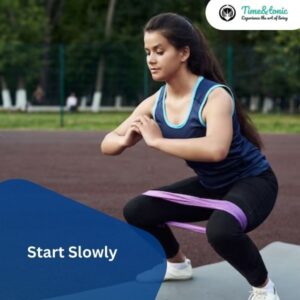18 Pro Tips for Walking to Lose Weight
In the pursuit of a healthier lifestyle and a fitter physique, the solution might be right at your feet: walking. This age-old practice, often underestimated in its effectiveness, holds the key to sustainable weight loss and improved overall well-being. The beauty of walking lies in its simplicity; it’s an activity practically anyone can engage in, regardless of age, fitness level, or location.
Welcome to our comprehensive guide, “Tips for Walking to Lose Weight.” In the pages that follow, we’ll explore the transformative power of walking and unveil a plethora of tips, techniques, and strategies to help you shed those extra pounds. Whether you’re a novice taking the first steps toward fitness or a seasoned walker looking to optimize your routine, this guide is tailored just for you.
Get ready to discover the art and science of walking for weight loss. From setting realistic goals to perfecting your walking form, from maintaining motivation to incorporating a balanced diet – we’ve got you covered. Let’s lace up those shoes and embark on this empowering journey together. Your path to a healthier, slimmer you begins right here.
How much walking is required to lose weight?
If your goal is weight loss, aiming to shed one pound per week is a reasonable and sustainable objective for most individuals. Walking serves as an accessible and low-impact method to support long-term weight loss.
When embarking on a new walking regimen, you can anticipate burning more calories initially, particularly if you’re starting with a heavier body, as it expends more energy. However, as you progress and lose weight, the rate of weight loss through walking may decelerate.
To effectively utilize walking for weight loss, maintaining a brisk pace is advisable. Here are some guidelines:
- Duration and Frequency: Aim to walk for 30 to 90 minutes on several days each week to promote weight loss. A brisk 30-minute walk typically covers a distance of 1.5 to 2 miles or equates to approximately 3,000 to 4,500 steps.
- Consistency is Key: Consistently sticking to your walking routine is crucial for burning calories, boosting metabolism, and forming healthy habits. Avoid skipping more than one day whenever possible. On days when you’re not walking, consider incorporating strength training exercises into your regimen.
- Progressive Approach: If you’re new to walking, begin with shorter walking sessions and gradually extend your walking time as your fitness level improves. This gradual progression will help prevent overexertion and injuries while steadily advancing toward your weight loss goals.
By adhering to these guidelines and maintaining a consistent walking routine, you can harness the power of walking as a reliable and effective tool for achieving and sustaining your weight loss objectives.
Also Read: Nourishing Low-Carb Dinners
Effective Tips for Walking to Lose Weight
Losing weight through walking isn’t just about putting one foot in front of the other; it’s a holistic approach that involves commitment, technique, and consistency. Here are some valuable tips for walking to lose weight:
Set Clear Goals

Setting clear goals is the compass that guides your weight loss journey. When you define your objectives with precision, such as losing a specific number of pounds within a designated time frame, you provide yourself with a roadmap. These goals serve as motivating milestones, keeping you focused and determined.
Clear goals not only provide direction but also offer a tangible way to measure your progress, boosting your confidence and enthusiasm. They transform abstract desires into achievable targets, giving you a sense of purpose and accomplishment with every step you take. So, take the time to set clear, realistic, and measurable goals; they are the foundation upon which your success is built.
Also Read: Best Remedies for Digestive Health
Start Slowly

Embarking on a weight loss journey demands patience and wisdom, and starting slowly is the cornerstone of sustainable progress. Rapid changes often lead to burnout or injuries, hindering your long-term goals. By beginning at a comfortable pace, your body gradually adjusts to the increased activity, reducing the risk of strains and fatigue.
This method also allows your mind to adapt, making the process more enjoyable and less overwhelming. Starting slowly fosters a sense of achievement with each milestone, building confidence and motivation. It establishes a strong foundation for enduring success, ensuring you stay committed and motivated throughout your journey towards a healthier, fitter you.
Use Proper Footwear

Choosing the right footwear is not just a matter of comfort; it’s a pivotal decision that impacts your entire walking experience and, consequently, your weight loss journey. Proper walking shoes provide essential support, cushioning, and stability, minimizing the risk of injuries and ensuring your feet are comfortable throughout your walk. Ill-fitted or worn-out shoes can lead to discomfort, blisters, and even long-term problems.
Investing in quality walking shoes tailored to your foot shape and walking style enhances your performance, making each step more efficient and enjoyable. The right footwear not only protects your feet but also boosts your confidence, allowing you to focus on your fitness goals without distractions. This is an essential tip that will help you while walking to lose weight.
Maintain Proper Posture

Maintaining proper posture while walking is akin to laying a solid foundation for a sturdy building. It is fundamental to effective weight loss through walking. Correct posture ensures that your body weight is evenly distributed, preventing strain on specific muscles or joints. Standing tall with your shoulders back not only prevents back pain but also engages your core muscles, enhancing calorie burn.
When your body is aligned correctly, you breathe more efficiently, allowing for better oxygenation of muscles, and leading to improved endurance. Additionally, good posture promotes balance, reducing the risk of falls or injuries. By prioritizing proper posture, you maximize the benefits of your walk, making each step count toward your weight loss goals.
Stay Hydrated

Staying hydrated is the unsung hero of any effective weight loss strategy, especially when it comes to walking. Water is your body’s natural fuel, essential for regulating temperature, aiding digestion, and supporting metabolism. When you’re well-hydrated, your energy levels soar, allowing for more productive and enduring walks. During physical activity, your body loses fluids through sweat, which must be replenished promptly.
Dehydration can lead to fatigue, cramps, and diminished performance. By sipping water before, during, and after your walk, you ensure your body functions optimally, maximizing the calorie burn and supporting your weight loss efforts. Hydration isn’t just a necessity; it’s a potent tool in your fitness arsenal.
Warm-Up and Cool Down

The significance of warming up and cooling down in your walking routine cannot be overstated. A proper warm-up readies your muscles, increasing blood flow and flexibility, and preparing your body for the workout ahead. It gradually elevates your heart rate and primes your respiratory system, reducing the risk of strains and injuries during your walk.
Conversely, cooling down allows your heart rate to gradually return to its normal rhythm, preventing dizziness and promoting recovery. It’s the bridge between intense activity and rest, aiding in the dissipation of lactic acid and reducing muscle soreness. By incorporating both, you safeguard your body, ensuring each step is effective and injury-free, enhancing the overall impact of your walking regimen.
Incorporate Intervals

Incorporating intervals into your walking routine is akin to adding a turbo boost to your weight loss journey. Intervals involve alternating between bursts of intense, fast-paced walking and periods of moderate-paced walking. This technique effectively elevates your heart rate, torches calories, and boosts metabolism, continuing to burn fat even after your walk ends.
The high-intensity intervals challenge your body, improving cardiovascular endurance and muscular strength. Moreover, it keeps your workouts engaging, preventing monotony, and stimulating continuous progress. By integrating intervals, you maximize the efficiency of your walk, transforming it into a potent fat-burning session, making each step a stride toward your weight loss goals.
Also Read: 9 Best Grocery Store Finds
Track Your Progress

Tracking your progress is the compass that ensures you stay on course during your weight loss journey through walking. Regular monitoring of your steps, distance covered, and calories burned provides tangible evidence of your efforts, motivating you to push further. It offers a clear picture of your achievements, transforming abstract goals into concrete accomplishments.
By observing your progress, you identify patterns, celebrate milestones, and make informed adjustments to your routine. Whether through a pedometer or a fitness app, this tracking not only boosts your confidence but also instills a sense of accountability. It transforms your walk from a mere activity into a purposeful, results-driven fitness regimen, fueling your determination to achieve your weight loss aspirations.
Make It Enjoyable

Making your walking routine enjoyable is the secret sauce that ensures long-term commitment to your weight loss goals. When you find joy in your walks, they transform from mere exercises into fulfilling experiences. Listen to your favorite music, engaging podcasts, or audiobooks while walking to make the time fly by.
Alternatively, explore scenic routes, parks, or beaches, immersing yourself in the beauty of nature. Walking with friends or family not only provides company but also turns your walks into social occasions, adding fun to fitness. Enjoyment diminishes the perception of effort, making your walks something to look forward to, and increasing the likelihood of staying consistent and dedicated to your weight loss journey.
Combine with a Balanced Diet

Combining your walking routine with a balanced diet is the ultimate recipe for successful weight loss. While walking burns calories, a balanced diet ensures you consume the right nutrients, making your weight loss efforts efficient and sustainable. Focus on whole foods rich in lean proteins, fiber, vitamins, and minerals.
Opt for a variety of colorful fruits, vegetables, whole grains, and lean proteins, avoiding processed foods and excessive sugars. Portion control is key; mindful eating prevents overeating and supports your calorie deficit. By nourishing your body with wholesome, nutritious foods, you provide the energy needed for your walks, enhance recovery, and enable your body to shed pounds effectively, maximizing the impact of your walking routine.
Be Consistent

Consistency is the bedrock upon which successful weight loss through walking is built. It’s not just about the steps you take today; it’s the collective effort of every day. Regular, consistent walking routines signal your body to adapt, enhancing endurance, strength, and overall fitness. Whether rain or shine, on good days and bad, sticking to your schedule ensures that your metabolism remains active, continuously burning calories.
Consistency solidifies your commitment, turning walking from a sporadic activity into a lifelong habit. Over time, those daily steps compound, resulting in significant weight loss and improved fitness. By embracing consistency, you’re not just walking; you’re walking your way to a healthier, lighter, and more confident version of yourself.
Stay safe
If you have safety concerns while you’re out for your walk, there are apps like ROAD iD that can provide peace of mind. These apps allow your friends and family to track your location in real time while you’re on your route. Additionally, they offer other safety features to enhance your overall security during your walk.
It’s essential always to remain aware of your surroundings when walking, especially if you’re in an unfamiliar area or walking during low-light conditions. In addition to using safety apps, a good practice is to inform a friend or family member about your walking plans beforehand. Share details about where you intend to walk and estimate when you expect to return home. This way, someone knows your whereabouts and can check in on you if needed, ensuring your safety during your walk.
Pick the best walking app for you.
Utilizing a walking app can serve as a valuable tool to maintain your motivation and monitor your walking achievements as you keep a record of your progress. For instance, apps like Pacer offer the functionality of a pedometer directly on your smartphone, allowing you to easily track your steps during your walk and throughout the entire day.
Pacer and similar apps can provide real-time step count data, which can be an excellent way to stay accountable and motivated during your walks. They enable you to set daily step goals, record your walking routes, and visualize your progress over time, making it easier to achieve your fitness and wellness objectives.
Alternatively, apps like 99 Walks offer a unique approach by fostering a supportive community and providing guidance specifically tailored to walking and weight loss. This community-driven experience can be particularly beneficial for individuals seeking not only to track their steps but also to connect with others who share their fitness goals, making the road to better health more fun and doable.
Take a walk for a good cause.
Numerous apps offer a unique feature that allows you to convert your daily steps into charitable donations. Here’s how it works: for every mile you walk or complete, the app donates a specified amount, typically around 25 cents, to a charity of your choosing.
Additionally, some of these apps provide an option to create a personal pledge page. This means that even if you’re not participating in a formal marathon or race event, you can still encourage your friends and acquaintances to sponsor your walking efforts. They can make donations to your chosen charity directly through your pledge page, further contributing to the charitable cause you’re supporting.
This innovative approach not only motivates you to stay active but also allows you to make a positive impact by supporting charities that matter to you while involving your social network in the process. It’s a win-win situation for both your health and the causes you care about.
Take a walk with a furry friend.
Engaging in regular walks can yield remarkable benefits for both you and your canine companion. For humans, this simple activity offers an array of advantages, including enhanced cardiovascular fitness, lower blood pressure, increased muscle strength, and a reduction in stress levels. It’s a key part of living a good life.
Equally important, regular walking plays a pivotal role in maintaining your pet’s well-being. Just like humans, dogs benefit from the physical activity that walking provides. It helps manage their weight, keeping them at a healthy and ideal size. Furthermore, consistent walks can reduce the risk of various medical complications in dogs, such as osteoarthritis and cardiovascular diseases.
If you’re looking to initiate a walking routine for both you and your furry friend, consider starting with an additional 10 minutes to your usual dog walk. This gradual approach allows both you and your pet to ease into the routine comfortably. Over time, you can gradually increase the duration and intensity of your walks, reaping the numerous physical and mental health benefits that walking together can offer.
Include some reverse walking.
Although it may sound unusual, reverse walking, which is essentially walking backward, offers a range of valuable health benefits. Beyond its unconventional appearance, this activity can significantly contribute to improving your overall well-being. Here’s why:
- Enhanced Body Coordination: Reverse walking challenges your body’s coordination and balance in a unique way. This exercise engages different muscle groups and requires increased spatial awareness, helping you become more coordinated over time.
- Strengthening Lesser-Used Leg Muscles: Unlike forward walking, which primarily targets specific leg muscles, reverse walking engages muscles that are typically underutilized. This can lead to improved strength in areas that may not receive as much attention during regular walking.
- Pain Reduction: A recent study has shown that reverse walking can be particularly beneficial for individuals with knee osteoarthritis. It has been found to reduce pain and enhance physical function, making it a potentially valuable addition to a rehabilitation or exercise routine for those with joint issues.
To incorporate reverse walking into your routine, consider adding short bursts of it a few times during your walk. However, it’s crucial to remain vigilant and aware of your surroundings to avoid any potential obstacles or hazards. This enjoyable and effective exercise can be an excellent way to add variety to your walking routine while reaping its unique health benefits.
Complete with a five-minute stretch.
Dedicating as little as five minutes to stretching after your walk can have a significant impact on your overall well-being. This post-walk routine offers several benefits, including improved flexibility and reduced risk of injury. Here’s why incorporating post-walk stretching is beneficial:
- Enhanced Range of Motion: Stretching after your walk helps increase your joints’ and muscles’ flexibility. This, in turn, enhances your overall range of motion, making everyday movements easier and less strenuous on your body.
- Injury Prevention: Stretching aids in preventing injuries by maintaining muscle and joint health. It can help alleviate muscle tension and reduce the risk of strains or sprains during subsequent walks or physical activities.
- Muscle Recovery: Engaging in static stretching for at least five minutes post-walk allows your muscles to recover more efficiently. Static stretching involves holding a muscle or joint in an extended position, promoting relaxation and relieving any built-up tension.
Some examples of static stretches that can be incorporated into your post-walk routine include the quadriceps stretch, hamstring stretch, and tricep stretch. These stretches target key muscle groups and contribute to muscle relief and relaxation, leaving you feeling more refreshed and rejuvenated after your walk.
Increase your intake of fruits and vegetables.
Fitness and a nutritious diet are interconnected pillars of a healthy lifestyle. When aiming to lose weight through walking, prioritizing the consumption of fruits and vegetables can be a highly effective approach. These natural, nutrient-rich foods play a vital role in reducing cravings and enhancing satiety, two significant obstacles often encountered during weight loss endeavors.
- Curbing Cravings and Enhancing Satisfaction: Increasing your intake of fruits and vegetables provides essential nutrients and fiber, curbing cravings for unhealthy snacks and promoting a sense of fullness. This contributes to better control over your appetite and caloric intake.
- Overcoming Common Weight Loss Roadblocks: Cravings and a constant feeling of hunger are common challenges while dieting to lose weight. By incorporating a variety of fruits and vegetables into your meals, you can navigate these hurdles more effectively, making it easier to maintain a calorie-controlled diet.
- Expert Recommendations: Health professionals emphasize the importance of consuming a sufficient amount of fruits and vegetables daily. They suggest a target of at least five servings per day, emphasizing the numerous health benefits associated with meeting this dietary goal.
Incorporating fruits and vegetables into your daily eating routine not only supports your weight loss journey but also promotes overall well-being. These natural foods contribute to a balanced diet, providing essential vitamins, minerals, and antioxidants that are vital for your body’s optimal functioning.
These are the most effective tips for walking to lose weight.
Also Read: Low-Carb Midnight Snacks
Benefits of Walking to Weight Loss
Walking is a powerful yet underrated tool in the realm of weight loss. Its simplicity often masks its effectiveness. Here are some compelling reasons why incorporating regular walks into your routine can significantly aid your weight loss journey:
1. Burns Calories: Walking, especially brisk walking, is a fantastic cardiovascular exercise that burns calories. The more calories you burn, the more potential you have for weight loss. By creating a calorie deficit (burning more calories than you consume), your body starts to shed excess fat, leading to weight loss.
2. Boosts Metabolism: Regular walking can boost your metabolism. As your metabolic rate increases, your body burns more calories even when you’re at rest. This means that the benefits of your walk extend beyond the activity itself, aiding in weight loss throughout the day.
3. Preserve Lean Muscle: Walking helps in preserving lean muscle mass while promoting fat loss. Maintaining muscle mass is crucial during weight loss as it keeps your metabolism high. Unlike extreme diets or excessive cardio, walking allows you to lose fat while retaining your hard-earned muscles.
4. Reduces Stress and Emotional Eating: Stress often leads to emotional eating and weight gain. Walking, especially in natural surroundings, can reduce stress by triggering the release of endorphins, the body’s natural stress relievers. By managing stress, you’re less likely to resort to unhealthy eating habits, facilitating weight loss.
5. Improves Digestion: Regular physical activity, including walking, aids in better digestion. A healthy digestive system ensures that your body efficiently absorbs nutrients and eliminates waste. Proper digestion can contribute to weight loss by optimizing your body’s processes.
6. Enhances Cardiovascular Health: Walking is excellent for your heart health. It strengthens your heart, improves circulation, and lowers blood pressure and cholesterol levels. A healthy heart means improved overall fitness and better capacity for physical activities, including more effective weight loss through walking.
7. Encourages Consistency: Walking is easy to incorporate into your daily routine. It doesn’t require special equipment or a specific location. This simplicity encourages consistency, a key factor in any successful weight loss endeavor. Regular, consistent walking builds a sustainable habit that can lead to significant and lasting weight loss results.
Simple methods to improve your daily walking step count
The most effective walking routines involve continuous walks that span extended periods. However, any amount of walking can yield the benefits mentioned above. If you’re struggling to find dedicated time for a daily walk, you can integrate walking seamlessly into your busy schedule.
Here are some simple ways to naturally increase your daily walking:
- Opt for stairs over elevators and walk up escalators instead of riding them.
- Incorporate three 10-minute walks into your day: in the morning, afternoon, and before bedtime.
- Purposefully choose to exit public transport a stop earlier to include more walking.
- Park farther away from store, office, and restaurant entrances rather than seeking a closer spot.
- Invite a friend for a walk-and-talk during lunch breaks on pleasant days.
- Stay in touch with family or friends over the phone while walking outside to enjoy their company and stay entertained.
- Set a timer to stand up from your desk at work and take several walks around your office throughout the day.
- Plan activities in nearby neighborhoods and leave your car at home if feasible; walking to and from these activities is an excellent way to stay active.
- Opt for in-person grocery shopping, wander the aisles, and carry your groceries home by hand whenever possible.
Conclusion
We have discussed valuable tips for walking to lose weight. In the rhythmic cadence of each step lies the transformative power to shape a healthier, lighter you. Through this comprehensive guide, you’ve unlocked the secrets to effective weight loss via walking. By setting clear goals, embracing proper techniques, and infusing each stride with determination, you’ve embarked on a journey toward wellness. Remember, every step counts; consistency is your ally. As you lace up your shoes and walk forth, know that you’re not just losing weight; you’re gaining a life brimming with vitality, confidence, and well-being. Your journey doesn’t end here; it simply evolves, guiding you toward a future of lasting health and happiness.
FAQ
Aim for at least 150 minutes of moderate-intensity aerobic activity, including walking, per week. Break this down into manageable chunks, like 30 minutes a day, five days a week, to achieve optimal results.
Set realistic goals, track your progress, vary your routes, and find a walking buddy or listen to music or podcasts to keep it enjoyable.
Walking alone can be highly effective for weight loss. However, combining it with a balanced diet and some strength training exercises can enhance your overall fitness, boost metabolism, and promote a healthy body composition.




